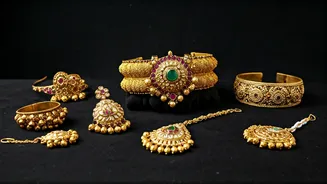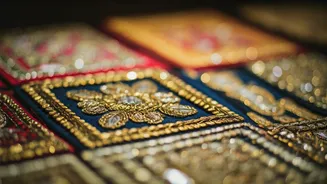Jadau: Royal Embellishments
Jadau jewelry, a testament to royal patronage, showcases gemstones meticulously set without the use of claws or prongs. Skilled artisans meticulously crafted
each piece, carefully positioning precious stones such as diamonds, emeralds, and rubies within a gold frame. Originating from the Mughal era, Jadau became a symbol of status and wealth, often adorning royalty and the nobility. This technique allows the gemstones' brilliance to shine, reflecting a rich cultural past. The intricate designs, often floral or geometric, underscore the jeweler's craftsmanship and aesthetic precision. Pieces are usually characterized by their elaborate settings, showcasing the gemstones and precious metals in a harmonious blend. Jadau jewelry continues to be highly valued for its craftsmanship and historical significance.
Meenakari: Enamel Artistry
Meenakari, or enamel work, provides a vibrant backdrop for the intricate designs of Indian jewelry. The art involves applying vibrant colors to the surface of metal, typically gold or silver, to create colorful and detailed patterns. This technique originated in Persia but flourished in India, particularly in Rajasthan and Varanasi. The process begins with engraving designs onto the metal, then filling the recessed areas with enamel. The piece is then fired to fuse the enamel with the metal. The enameling process can incorporate multiple layers of color, often creating depictions of flowers, birds, and other intricate motifs. Meenakari jewelry is appreciated for its vibrant colors and delicate details. The final effect is a jewel with a striking visual appeal and cultural narrative.
Kundan: Gemstone Setting
Kundan jewelry focuses on setting gemstones with gold, using a technique dating back to the Mughal period. The process involves placing gemstones on a base, then securing them with gold foil. The gold is meticulously pressed to firmly secure the stones, often creating a seamless appearance. This setting method allows the gemstones to take center stage, maximizing their sparkle. Kundan jewelry, typically set with uncut diamonds, emeralds, and rubies, holds a prominent position within Indian wedding and festive traditions. The style's elegance stems from the clean lines and exquisite choice of precious stones. Kundan jewelry has been seen as a way of displaying status and wealth throughout Indian history.
Polki: Uncut Diamonds
Polki jewelry features uncut diamonds, keeping the raw beauty of the gems. These diamonds are set in gold without any facets, retaining their natural brilliance and rough texture. Polki is a very old practice in India and is often paired with Kundan settings. The stones are sourced from around the world but often from India. Polki jewelry stands out for its unique, organic charm, celebrating the inherent qualities of diamonds. Polki jewelry has maintained a substantial presence throughout Indian jewelry practices. Polki continues to be a favorite choice for bridal and formal occasions, and it is seen as a symbol of tradition and status.
Temple: Sacred Designs
Temple jewelry is inspired by the architecture and deities found in South Indian temples, often incorporating religious symbols and motifs. The designs typically include gods, goddesses, and other religious figures, crafted with intricate detail. This style of jewelry is commonly fashioned using gold, with elaborate ornamentation like carvings, filigree, and embellishments of gemstones. This jewelry is traditionally worn during religious ceremonies and celebrations. It serves as a tribute to faith. Temple jewelry has evolved from being used within temple settings to becoming an important part of personal adornment and cultural expression. The motifs found on temple jewelry may vary, from depictions of deities to symbolic designs.
Navratna: Nine Gems
Navratna jewelry uses nine gemstones, each assigned to a celestial body in Hindu astrology. These gems are the diamond, pearl, red coral, emerald, yellow sapphire, diamond, blue sapphire, hessonite garnet, and cat's eye chrysoberyl. The arrangement of the stones is based on their association with various planets. The jewelry is considered auspicious, with the belief that wearing all nine gems can promote health, wealth, and general well-being. Navratna jewelry has a traditional importance for many Hindus. Each gemstone offers its own power and qualities, and together they are thought to bring balance and harmony to the wearer. The jewelry pieces can include rings, pendants, and necklaces.
Filigree: Woven Metal
Filigree jewelry is a delicate style created by twisting fine metal wires, usually gold or silver, into intricate designs. These wires are then soldered onto a base or frame, forming openwork patterns. The technique demands remarkable skill and patience, as each piece is essentially hand-woven from metal. Filigree work is famous for its lacy appearance. It can be found in various jewelry pieces, including earrings, bracelets, and pendants. The process is time-consuming, and the intricate patterns are highly valued for their finesse. Filigree jewelry showcases the craftsman's attention to detail, creating elegant and airy designs. Filigree is worn with special outfits and provides a beautiful contrast to more solid, elaborate pieces.











